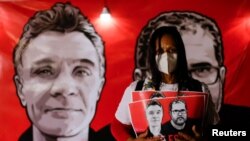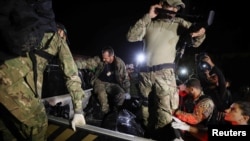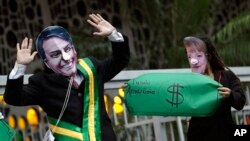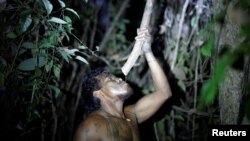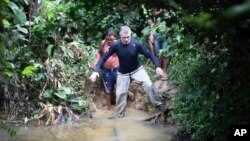When Brazilian journalist Adecio Piran saw a WhatsApp message that British journalist Dom Phillips was missing in the Amazon, a shiver ran down his spine.
Phillips was known for his coverage of environmental issues like illegal logging and poaching, writing for The Guardian, The Washington Post and others.
Now he and Bruno Pereira, an Indigenous expert traveling with him in the remote Javari region, had vanished.
Piran, who works in Brazil’s northern state of Para, recalled thinking, "That could have happened to me."
"I felt like I was in their place. I was shocked. A movie goes through your head," he told VOA.
The search for Phillips and Pereira culminated Wednesday when authorities announced that a suspect had confessed to being involved in their killing and directed police to where they could recover the bodies.
A forensic examination of those remains was under way Friday.
Conflict and coverage
The apparent killing of a high-profile journalist has renewed focus on the risks for those investigating environmental issues.
"All these drivers make up this scorched earth scenario that we live in the Amazon," said Danicley de Aguiar, from Greenpeace Brazil.
"Environmental crime has become organized. And every time a journalist dares to speak about the silencing process of social leaderships, they become a target alongside the leadership."
Piran knows what that feels like.
In August 2019, he broke a story about coordinated efforts by ranchers, farmers and others to burn newly deforested land in what became known as the “Day of Fire.”
They wanted to send a message to Brazil’s president, Jair Bolsonaro, that they agreed with his vision to develop the Amazon and were ready to work, burning forests to clear land for grazing.
The story – covered by other journalists, including Phillips – sparked international condemnation and a backlash from the “Day of Fire” perpetrators.
“It turned into a mess, like a Western movie, like I was wanted,” Piran recalled. Leaflets bearing his photo were distributed, and threatening messages appeared in WhatsApp and other social media.
"I couldn’t walk on the streets," he said. "It was horrible; I don’t even want to remember that."
The journalist had to leave his home until tensions eased.
Protect or develop?
Bolsonaro in 2018 made clear his intent to open the Amazon for development.
Since then, commercial pressure on the Amazon – a vast area seen as vital for its ecological diversity and as a buffer against global warming – increased.
Deforestation hit record highs year after year, and a 2021 report from the international environmental organization Global Witness ranked Brazil as one of the most dangerous countries in the world for environmentalists, with 20 killed in 2020.
Killings on Indigenous lands also increased, with 182 cases recorded in 2020, up from 113 in 2019, according to a report by the Missionary Council for Indigenous Peoples (CIMI).
“Conflicts relating to territorial rights” more than doubled, the council said.
Activists, environmentalists, journalists and Indigenous people are on the front lines.
"The people at the forefront of this fight to protect our lands, like me, like Indigenous leaders, have a target on our back. We put our lives at risk," said Natim Guajajara, who is part of the Guardians of the Forest group.
The Guardians, with more than 100 Guajajaras, one of the country’s largest Indigenous groups from the eastern part of the Amazon, was formed in 2013 to fight illegal logging gangs.
One of their members, Paulo Paulino Guajajara, was killed in 2019, and a Guajajara leader and supporter of the Guardians named Zezico Rodrigues Guajajara was killed the following year.
No one has been brought to justice.
The risks ripple through the region, with threats coming from a range of interests.
"There is a history of this predatory occupation in the Amazon. There are politicians involved, wildcat miners involved, and illegal loggers involved. These are different groups with the same interest that have gotten together to destroy the Amazon," said Arison Jardim of the Apiwtxa Association, which protects the interests of the Ashaninka people of Acre state.
Jardim is a journalist and communications adviser for the association.
Phillips, who was working on a book about conservation efforts in the Amazon, visited Acre state and the Ashaninka people before joining Pereira in Vale do Javari.
Bordering Peru and Colombia, Vale do Javari has the second-largest Indigenous territory in Brazil, and the biggest concentration of isolated and newly contacted indigenous people.
Drug trafficking gangs have control of its waterways to transport cocaine. Poaching, illegal logging, fishing, and wildcat mining (known as garimpo) activities "have been systematically denounced by the indigenous organizations in the region,” said Guenter Francisco Loebens, a missionary from CIMI. "It is a constant threat."
Although many indigenous communities have been able to build a network of information sharing with social media and their own news organizations, journalists are essential to helping shed light on issues affecting those in Vale do Javari.
People like Phillips and Pereira did precisely that. They started working together in 2018 after the journalist joined one of Pereira's expeditions. It was a perfect match: Pereira had connections and the trust of the people in the rainforest. Phillips had the means to expose their concerns.
Over his 14 years living in Brazil, Phillips had put much of his effort into environmental reporting. The June trip was meant to be one of his last for the book, The Guardian reported.
They were last seen in their boat on June 5, in an area where clashes regularly occur between fisherman, poachers and government officials.
Pereira had alerted authorities about threats since April, when he told Federal Police and prosecutors about organized illegal fishing and poaching in the valley, the Brazilian newspaper O Globo reported.
Piran understands the lasting impact of such threats.
After his “Day of Fire” experience, he returned to his home in Novo Progresso but refrains from writing about similar topics.
He thinks the killing of Phillips and Pereira may have a similar effect on other reporters.
"Look at the gravity of this case. How horrible it is. I believe that this situation, I can be mistaken, but I believe will suppress many things," Piran said. "Brazilian journalists, especially environmental ones, have their days counted, it seems."




